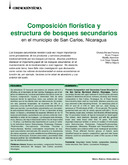| dc.contributor.author | Ferreira, Chelsia Moraes | |
| dc.contributor.author | Finegan, Bryan | |
| dc.contributor.author | Kanninen, Markku | |
| dc.contributor.author | Delgado, Luis Diego | |
| dc.contributor.author | Segura, Milena | |
| dc.date.accessioned | 2015-03-19T18:57:51Z | |
| dc.date.available | 2015-03-19T18:57:51Z | |
| dc.date.issued | 2002-04 | es_ES |
| dc.identifier.issn | e-ISSN: 1021-0164 | es_ES |
| dc.identifier.uri | https://repositorio.catie.ac.cr/handle/11554/5723 | |
| dc.description | 7 páginas, 4 ilustraciones, 1 tabulaciones, 22 referencias. | |
| dc.description.abstract | Se estudiaron 12 bosques secundarios de edades entre 6 y 25 años, en el municipio de San Carlos, Nicaragua, con el objetivo de determinar y evaluar parámetros florísticos como estructura, composición, riqueza y diversidad. Seis de estos bosques tenían la agricultura como uso anterior del suelo mientras que en los demás éste era desconocido. Se instalaron seis parcelas temporales de muestreo de 250 m2 y cuarenta y cinco de 450 m2, procurando un mínimo de 15 fustales por parcela. Los resultados presentados son únicamente para especies leñosas de dap = 10 cm. La densidad, el área basal, la riqueza y diversidad de especies difirieron en los 12 bosques estudiados, aumentando sus valores conforme incrementaba la edad de los bosques. Los bosques más diversos, ricos, densos y de mayor área basal fueron los de mayor edad (mayor que 16 años). Las familias más importantes en cuanto al número de individuos fueron: Sterculiaceae, Rubiaceae, Fabacea/Papilionoidea, Cecropiaceae, Ulmaceae, Tiliaceae y Anacardiaceae, familias comúnmente encontradas en bosques secundarios neotropicales. De acuerdo a la importancia de ciertas especies, se pudo establecer tres diferentes grupos florísticos de bosques; factores como edad y proximidad entre bosques podrían ser considerados como algunas de las causas de similitud entre ellos. | en_ES |
| dc.description.abstract | Twelve secondary forests with ages between 6 and 25 years old were studied to determine structure, richness, diversity and floristic composition in San Carlos, Nicaragua. Six of these forests have recently been used as crop lands whereas; previous use was unknown in the remaining forests. Six temporary plots of 250 m2 and 45 of 450 m2 were laid out, each having a minimum of 15 individuals of dbh major who 10 cm per plot. The results presented here are only for woody species with dbh = 10 cm. The density, basal area, richness and diversity differed among the 12 secondary forests; all figures increased as forest aged. The richest, most diversed, densiest and with the greatest basal area were those older than 16 years. The most important botanical families in terms of number of individuals were Sterculiaceae, Rubiaceae, Fabacea/Papilionoidea, Cecropiaceae, Ulmaceae, Tiliaceae and Anacardiaceae. All these families are common within most neotropical secondary forests. Three different floristic groups of forests were identified based on species composition; age and inter-forest distance could be considered as some of the causes of their similarity. | |
| dc.language.iso | es | es_ES |
| dc.publisher | CATIE, Turrialba (Costa Rica) | es_ES |
| dc.relation.ispartof | Revista Forestal Centroamericana, Número 38 (abril-junio 2002), páginas 44-50 | |
| dc.rights | info:eu-repo/semantics/openAccess | |
| dc.subject | BOSQUE SECUNDARIO | es_ES |
| dc.subject | BIODIVERSIDAD | es_ES |
| dc.subject | INVESTIGACIONES | es_ES |
| dc.subject | VEGETACION | es_ES |
| dc.subject | NICARAGUA | es_ES |
| dc.subject | BOSQUES | |
| dc.subject | COMPOSICION BOTANICA | |
| dc.subject | RECURSOS NATURALES | |
| dc.title | Composición florística y estructura de bosques secundarios en el municipio de San Carlos, Nicaragua | es_ES |
| dc.title.alternative | Floristic composition and secondary forest structure in the San Carlos municipal district, Nicaragua | es_EN |
| dc.type | Artículo | es_ES |


